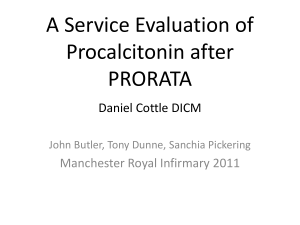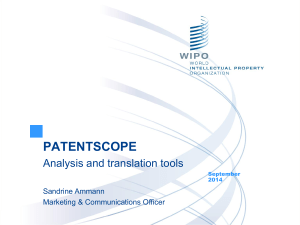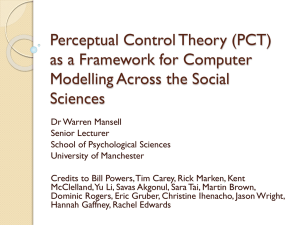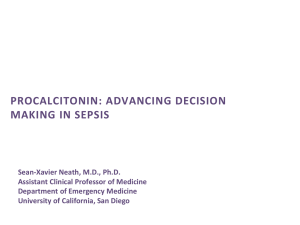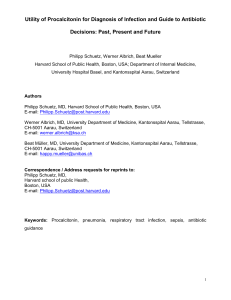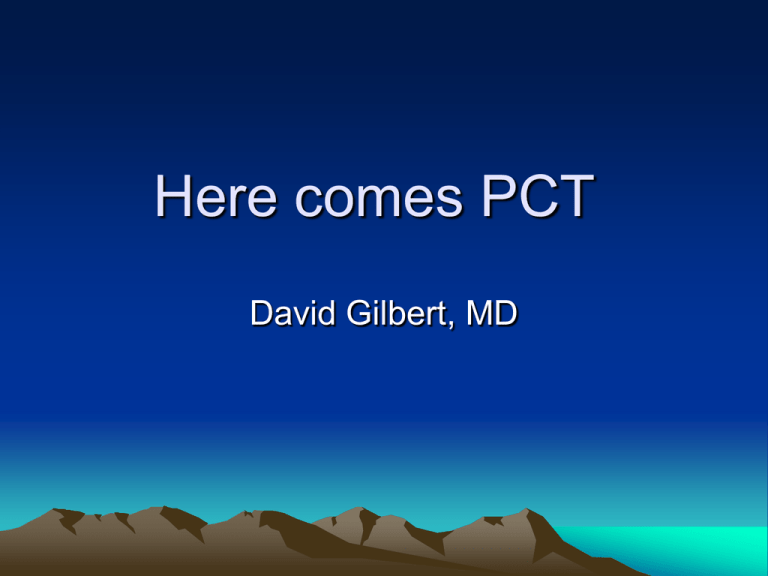
Here comes PCT
David Gilbert, MD
Disclosures
• Advisory/Consultant: Pfizer, Bayer,
Schering-Plough, Pacific Bioscience,
Advanced Life Science, Wyeth, Roche,
Johnson and Johnson, Achaogen
• Speaker: Merck
Major Problem
• Increasing resistance of major bacterial
pathogens to licensed antibacterials
• Discovery and development of new
antibacterials is at a low ebb.
• Hence, we need to be good stewards of
the drugs that are still active.
How to reduce empiric use of
antibacterials?
• Rapid point of care microbial diagnosis.
Especially helpful in respiratory tract
infections. Example: rapid test for gp.A
streptococci
• Multiplex PCRs for common viral and
bacterial pathogens would be ideal. A few
are FDA approved. Clinical integration
slow.
Surrogate Markers of Bacterial
Invasive Disease
• Until such time as multiplex PCRS are
available, we are left with surrogate
markers
• Have used fever, WBCs, C-reactive
protein levels and ESR in this way for
many years. Too insensitive and nonspecific
• A new biomarker is procalcitonin (PCT).
• See what you think?
Procalcitonin
• The 116-aminoacid precursor
(prohormone) of the 32-aminoacid
hormone—calcitonin
• Calcitonin produced in neuroendocrine Ccells of thyroid and K-cells of the lung
• Pro-CT produced in all parenchymal
tissues and monocytes/macrophages
Crit.Care Medicine 2008; 36; 941&1684
Calcitonin vs ProCT
• Calcitonin lowers
serum calcium
• Produced only in
thyroid and selected
lung cells
• Levels do not
increase in response
to bacterial infection.
• ProCT is intimately
involved with the
inflammatory process
• Produced by
monocytes, fat cells,
R-E system, adrenal,
G-I tract and more
• Rapid large increases
in serum levels within
3-6 hrs of onset of
bacterial infection
What is physiologic role of PCT?
• Not yet completely understood
• Increases synthesis of nitric oxide
• Antibody to PCT increases survival of
septic pigs
What elevates serum levels of
PCT?
• Acute local and invasive bacterial infections.
• Low perfusion states that may allow
translocation of normal flora: major surgical
procedures, trauma with shock, severe burns,
severe cardiogenic shock, ischemic bowel
• Systemic fungal infections; falciparum malaria
• Small cell lung Ca; Medullary thyroid Ca
• Clinically, interested in PCT levels in RTIs and
Sepsis
PCT serum levels
• Levels rise within 3-6 hrs of onset of bacterial
infection.
• Degree of elevation correlates with severity of
bacterial infection
• FDA-approved Immunoassay is sensitive,rapid,
and specific.
• Levels range from < 0.05 to over 1,000 ng/ml
• Sequential levels useful in diagnosis, prognosis,
and assist in duration of therapy
• Low levels have excellent negative predictive
value
PCT Levels as Guide to Therapy of
Respiratory Tract Infections(RTIs)
• Bulk of data from Switzerland
• Used sensitive PCT assay
• If randomized to PCT group, use of
antibacterials encouraged or discouraged
by PCT result
• Assumption: If patients recovered without
an antibacterial, likely that no serious
bacterial infection was present
PCT-Guided Therapy of AECB*
• Randomized controlled blinded trial at
Univ. Hosp. in Switzerland
• Patients Admitted from ER with steroids
and inhalers and then randomized
• Group 1. Standard therapy by attending
MD. PCT levels kept blinded
• Group 2. PCT levels provided and,
depending on result, discouraged or
encouraged, use of antibiotics
Chest 2007; 131:9-19
PCT-Guided Therapy of AECB
• PCT levels available within 1 hour, 24/7
• If PCT level < 0.1 ng/ml: “No bacterial
infection. Discourage use of antibiotics”
• If PCT level > 0.25 ng/ml: “Use of
antibiotics encouraged”
• Outcome assessment: Antibiotic use
acutely and over 6 months. Need for ICU
and other secondary endpoints
Results: AECB
Variable
PCTGuided(102)
Not PCTGuided (113)
Antibiotic
40%
72%
Clin. Success
84
89
ICU admit
8
11
Death, any cause
5
9
Positive sputum*
37
40
Viral studies
None
None
*Did not correlate with PCT levels
AECB study limitations
• One hospital; only inpatients
• Ultimately need large multicenter trial that
includes both inpatients and outpatients
• Future study: If PCT serum level < 0.1
ng/ml, randomize to either placebo or
antibiotic
• Hopefully include sputum cultures and
viral studies
PCT Guidance of Antibiotic
Therapy of CAP*
• Randomized, controlled, blinded trial in
Swiss University Hospital
• Patients admitted from ER with CAP
• All had PCT levels
• Controls: Treating MDs not given results of
PCT serum level
• PCT group: Treating MDs given results
with suggestions as to antibiotic use.
AJRCCM 2006; 174:84
Chest 2007;131:9
High Levels of PCT in the “septic”
patient
• Increases likelihood of bacterial sepsis;
Differentiates bacterial from viral infection
• Predicts prognosis of bacterial sepsis
• Differentiation of infectious and noninfectious etiologies of inflammation.
• As a guide to the duration of antibiotic
therapy.
PCT: Marker of Sepsis in ICU*
*CCM 2000:28:977. PCT level of >0.5 ng/ml
How well does PCT differentiate
bacterial and viral infections?*
• 360 children admitted from ER with
temperature > 38.5o C.
• Responsible pathogen identified.
• Divided into 3 groups:
• Gp. 1: Invasive bacterial infection
• Gp. 2: Localized bacterial infection
• Gp. 3: Viral infection
Ped. Inf. Dis. 1999; 18: 875-81
PCT: Bacterial or viral infection?
Result
Group 1
Group 2
Group 3
Diagnosis
Meningitis
or
bacteremia
46
Local.
Bacterial
infection
78
Viral
infections
1 mo-15 yr
2 mo-15 yr
1 mo-15 yr
N.meningitidi S.pyogenes,
s, S.pneumo, E.coli,
E.coli
Salmonella
Enterovirus,
influenza,
Number of
patients
Age range
Example
pathogens
236
adenovirus,RSV
, EBV
Correlation of Peak PCT Level and
90 Day Mortality*
PCT: max. level, ng/ml
Mortality, %
<1.0
5
1-5
11
6-20
28
21-50
37
51-1000
42
CCM 2006;34:2596
PCT is low in non-bacterial
infectious causes of SIRS*
• Viral infections: unless bacterial superinfection
• ARDS (CCM 1999; 27:2172)
• Sterile necrotizing pancreatitis (Gut 1997;
41:832)
• Post-liver transplant rejection (CCM 2000;
28:555)
SIRS= Systemic Inflammatory Response Syndrome
7:2175
ARDS:Bacterial or not?
Sequential PCT levels can shorten
antibiotic therapy in septic patients*
• Randomized, controlled, open intervention
trail in ICU septic and septic shock
patients.
• Daily PCT levels
• Standard of care vs. “stop” rules
• Stop if PCT fell 90% from baseline peak
• Stop if absolute value of < 0.25 ng/ml
• Stop if baseline < 1 and level now <0.1
AJRCCM 2008;177:498
PCT levels at PPMC
• Ultra-sensitive, FDA-approved assay
available 24/7 starting 9/15/08
• Results in < I hr.
• Cost: $68 (CBC $30; Antibiotic $20-120)
• Encourage use: ER, ICU, Hospitalists,
Primary Care Physicians, and others.
Procalcitonin Levels: Summary
• Sensitive and specific biomarker for bacterial
infection
• PCT levels augment, do not replace, clinical
assessment of patients with RTIs, suspected
and proven sepsis
• Will hopefully result in reduced use of empiric
antibiotics
• Sequential levels hopefully will decrease the
duration of antibiotic therapy in some patients.
Antibiotic Stewardship
• CDC,FDA, NIH, CMS all looking for ways
to avoid overuse of antibiotics for nonbacterial Respiratory Tract Infections.
• Procalcitonin needs further study, but
based on current evidence, low ProCT
levels (<0.25 ng/ml), suggest a low priority
for antimicrobial therapy in patients with
upper and lower respiratory tract
infections.
Can we rapidly discriminate
bacterial from viral RTI?
• Sinusitis, otitis, acute bronchitis, AECB,
and even CAP
• Clinical picture often does not allow
discrimination
• ESR, CRP no help
• Eventually, point of care multiplex PCR
• For now, rapid procalcitonin (ProCT)
assay available.
Procalcitonin Serum Levels
• FDA-approved antibody based assay
system
• Very sensitive: quantifies levels from 0.05
to 1000 ng/ml
• Answers in less than 1 hour.
ProCT and Viral Infections
• Of 236 viral infections, only 3 had serum
ProCT levels > 2 ng/ml
• Viral meningitis, < 1 ng/ml; bacterial
meningitis, very high levels ( approx. 10
ng/ml)
• Stimulated European studies designed to
determine if ProCT levels could guide
antibiotic use for RTIs
Eur.resp.journal 2007;30:556
Main Points
• Resistance is everywhere
• Impressive array of mechanisms of
resistance
• Vaccines can have a major impact on
incidence of invasive bacterial disease
• To preserve activity of current drugs, need
less empiric use. How? Surrogate
markers for bacterial infection or rapid ID
of specific viral or bacterial pathogen
Resistance is everywhere:
S.aureus
• World-wide epidemic of CA-MRSA
• Roughly 50 % of S.aureus isolates at
PPMC are MRSA
• In USA in 2005, 8987 cases of invasive
disease with 13 % mortality. More deaths
than from AIDS. (JAMA 2007;298:1763)
• Concomitant increase in vancomycin
resistance
Anti-MRSA Drugs
• Licensed: Vanco, TMP/SMX, Doxy,
Clinda, Linezolid, Quinupristin-dalfopristin
• In development: Dalbavancin, Telavancin,
Ortivancin, Ceftobiprole, Ceftaroline,
Iclaprim
Resistance is everywhere:
S.pneumoniae
• Changed in vitro criteria for resistance,
and hence, reduced prevalence of
resistance to penicillins
• Resistance to erythromycin, azithromycin,
clarithromycin now roughly 50 %
• If allergic to penicillin and macrolide
resistant isolate, treatment options:
Fluoroquinolone, Clinda, Linezolid
Resistance is everywhere: FQs and
Gram-negative Bacteria
• Resistance of N.gonorrhaeae to FQs
• Resistance of salmonella and
camplyobacter to FQs
• Resistance of E.coli, P.aeruginosa, and
Acinetobacter species to FQs
Resistance is everywhere: “R” of
GNBs to beta-lactams
• Increasing resistance of aerobic GNBs to
ESPs, ESCs, BL/BLIs, Carbapenems
• Mostly enzymatic: Chrom.-inducible
cephalosporinases, ESBLs,
KPCs(KIebsiella Producing
Carbapenemases
• Empiric treatment of VAP in NYC: colistin
and tigeclycline
• Pipeline drugs for P.aer., Acinetobacter: 0
How do bacteria survive in
presence of antibacterials?
• Synthesis of enzymes that alter the drug
• Change the drug target
• Pump the drug out before target is
reached
• Make the cell wall impermeable
• Make the target irrelevant; generative
alternative synthetic pathways
Genetics of Resistance
• Resistance can occur from mutations.
Once resistance present, spreads by
genetic exchange, e.g.:
• Bacteriophages
• Transformation: update and incorporation
of naked DNA (recycling)
• Spread of plasmids by conjugation
(bacterial sex).
Vaccines to Prevent Invasive
Bacterial Disease
• Haemophilus influenza type b, protein
conjugate vaccine
• Pneumococcal conjugate vaccine
19F to 19A: Watch Out!
• Several reports of emergence of serotype
19A as a virulent and multidrug resistant
pneumococcus:”replacement
pneumococcal disease”
• Serotype 19F is in protein conjugate
vaccine; 19A is not.
• Rate of Invasive Pneumococcal Disease in
immunized alaskan children increased
from 134 (2001-2003) to 245 (2004-2006)
per 100,000.
In vitro susceptibility of 19A?
Drug
MIC90
Penicillin G
6
Suscept.
Interpretation
R
Amoxicillin
6
R
Ceftriaxone
2
Intermediate
Azithromycin
>256
R
Vaccines are not the answer
• H.influenza And pneumococcal vaccines
successful, but no vaccines for S.aureus
or common gram-negative bacteria
• Answer to resistance is to use
antibacterials less often and, when used,
for shorter periods of time.

